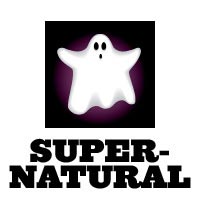 Supernatural Films: These are films that have themes
including gods or goddesses, ghosts, apparitions, spirits, miracles, and other
similar ideas or depictions of extraordinary phenomena. They may be combined
with other genres, including comedy, sci-fi, fantasy or horror.
Interestingly however, until recently, supernatural films were usually presented
in a comical, whimsical, or a romantic fashion, and were not designed to frighten
the audience. There are also many hybrids that have combinations of fear, fantasy,
horror, romance and comedy. Supernatural Films: These are films that have themes
including gods or goddesses, ghosts, apparitions, spirits, miracles, and other
similar ideas or depictions of extraordinary phenomena. They may be combined
with other genres, including comedy, sci-fi, fantasy or horror.
Interestingly however, until recently, supernatural films were usually presented
in a comical, whimsical, or a romantic fashion, and were not designed to frighten
the audience. There are also many hybrids that have combinations of fear, fantasy,
horror, romance and comedy.
Films with Benevolent Ghosts:
Ghosts as the subject of films date back to World War II era
and post-war romantic comedies. A lengthy list
of films with angels in them can be found in the genre section on fantasy films. Originally,
supernatural apparitions were not intended to frighten audiences, but to entertain
as they assisted earth-bound characters out of crazy predicaments, or interacted
with them. For example:
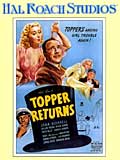 the
late 30s Topper (1937), with Cary Grant and Constance Bennett
as George and Marion Kerby, a mischievous ghostly couple who, after a car
accident, bedevil stuffy banker Cosmo Topper (Roland Young) (with a nagging
wife (Billie Burke)) into having a new zest for life; the ghosts are invisible
to everyone but Topper; followed by two sequels to complete the Hal Roach
Studios trilogy (Topper Takes a Trip (1939) and Topper
Returns (1941)), a TV series starring Leo G. Carroll, and a television
movie in 1979 the
late 30s Topper (1937), with Cary Grant and Constance Bennett
as George and Marion Kerby, a mischievous ghostly couple who, after a car
accident, bedevil stuffy banker Cosmo Topper (Roland Young) (with a nagging
wife (Billie Burke)) into having a new zest for life; the ghosts are invisible
to everyone but Topper; followed by two sequels to complete the Hal Roach
Studios trilogy (Topper Takes a Trip (1939) and Topper
Returns (1941)), a TV series starring Leo G. Carroll, and a television
movie in 1979- the classic fantasy romantic comedy Here Comes Mr. Jordan
(1941), a Best Picture Oscar nominee with Robert Montgomery as soprano
saxophone-playing, champion boxer Joe Pendleton who is killed in a fighter
plane crash, but in Heaven is told there's been a mix-up and he has shown
up 50 years before his time, due to an error by an inexperienced and scatterbrained
heavenly messenger (Edward Everett Horton); celestial bookkeeper Mr. Jordan
(Claude Rains) sends him back to Earth, where his body has already been
cremated, so he must inhabit the body of a soon-to-be murdered millionaire
crook; the film was remade twice - as a semi-sequel musical Down to Earth
(1947) with Rita Hayworth, and most recently inspiring Warren Beatty's
updated Heaven Can Wait (1978) with the sport changed to pro football
(Joe Pendleton's position was quarterback for the LA Rams) - this was the
third teaming of Beatty with Julie Christie (following their appearances
in McCabe & Mrs. Miller (1971) and Shampoo (1975))
 Abbott
and Costello's haunted/abandoned house comedy Hold That Ghost (1941),
the second (released third) of their feature films Abbott
and Costello's haunted/abandoned house comedy Hold That Ghost (1941),
the second (released third) of their feature films- French director Rene Clair's best Hollywood picture I
Married a Witch (1942) with Veronica Lake as a sexy Salem witch (previously
burned at the stake) who, with her sorcerer father, returns to haunt the
descendant (Fredric March) of her condemning Puritan accusers, but then
romance develops; the film may be the basis for the popular TV series Bewitched
- Ernst Lubitsch's witty, Technicolor fantasy/comedy Heaven
Can Wait (1943), the director's first film in color; about a recently-deceased
former lothario (Don Ameche) who recounts his sexual philandering life history
in Hell to the Devil - His Excellency (Laird Creger)
- Noel Coward's and David Lean's British fantasy/supernatural
comedy farce Blithe Spirit (1945) with an innovative use of color
cinematography to accentuate the ghosts; about the eccentric, mischievous
ghost (Kay Hammond) of a novelist's (Rex Harrison) 1st wife who attempts
to break up his 2nd marriage to a strait-laced woman (Constance Cummings),
and the efforts of a medium (Margaret Rutherford) to exorcise the offending
spirit
- in the Technicolor, Goldwyn-produced Wonder Man (1945),
Danny Kaye starred as identical twins with strikingly-different personalities:
a timid bespectacled librarian and a nightclub emcee (who became a ghostly
spirit and then entered his brother's body)
-
 the
much-loved, all-time Christmas classic It's A Wonderful Life (1946), with guardian angel Clarence (Henry
Travers) who convinces a despairing, small-town good man/bank manager (James
Stewart) to refrain from suicide by showing him how wretched the town would
have been without him the
much-loved, all-time Christmas classic It's A Wonderful Life (1946), with guardian angel Clarence (Henry
Travers) who convinces a despairing, small-town good man/bank manager (James
Stewart) to refrain from suicide by showing him how wretched the town would
have been without him
- the sentimental angel tale The Bishop's Wife (1947) with an overworked and harrassed bishop (David Niven), his neglected
wife (Loretta Young), and an angelic suave stranger (Cary Grant) who helps
the bishop raise money for a new church; remade in director Penny Marshall's The Preacher's Wife (1996)
- Joseph Mankiewicz' turn of the century romantic fantasy The Ghost and Mrs. Muir (1947), about a young and independent, but
lonely widow Lucy Muir (Gene Tierney) who discovers a salty, hot-tempered
naval captain (Rex Harrison) as a ghostly presence in her English seaside
Gull Cottage
Suspenseful Ghost Tales:
However, a few films in the mid-1940s established ghosts and
the power of the supernatural as serious horror themes:
-
 Paramount's
suspenseful, Gothic-style haunted house tale, a great ghost film, The
Uninvited (1944) about a music critic (Ray Milland) and his sister (Ruth
Hussey) who purchase a spooky Welsh/Cornish coast seaside home with vengeful
spirits and eerie occurrences (the smell of mimosas, unexplanably chilled
rooms, flickering candles, opening and closing creaking doors, supernatural
apparitions, the sound of sobbing and moaning in the night, wilting flowers) Paramount's
suspenseful, Gothic-style haunted house tale, a great ghost film, The
Uninvited (1944) about a music critic (Ray Milland) and his sister (Ruth
Hussey) who purchase a spooky Welsh/Cornish coast seaside home with vengeful
spirits and eerie occurrences (the smell of mimosas, unexplanably chilled
rooms, flickering candles, opening and closing creaking doors, supernatural
apparitions, the sound of sobbing and moaning in the night, wilting flowers)
- Britain's classic, all-time suspenseful, episodic masterpiece Dead of Night (1945), an anthology composed of three chilling tales;
especially remembered for the sequence of a ventriloquist terrorized by
his demonic and sinister dummy
- The Picture of Dorian Gray (1945), adapted from
Oscar's Wilde's tale and an updating of the Faustian legend; about a vain
and handsome Dorian Gray (Hurd Hatfield) in Victorian London who sells his
soul for eternal youth in an unholy pact with the Devil, but turns morally
ugly nonetheless; in the climax, his true age is revealed in a life-sized,
Technicolored attic portrait
Val Lewton also produced a series of atmospheric supernatural
horror films in the 1940s, including the cult horror classic Cat
People (1942) and its fantasy follow-up Curse of the Cat People
(1944).
 Supernatural/Religious
Films: Supernatural/Religious
Films:
A few other films during the 1940s also told stories that
mixed religion and the supernatural. The Devil and Daniel Webster (1941) was
the classic Stephen Vincent Benet folkloric tale of an 1840s New Hampshire
farmer selling his soul to the devil, and has the deal argued by famed lawyer
Webster. Another excellent guardian angel fantasy film was the sentimental
WWII era film A Guy Named Joe (1944), about an angelic flier who navigates
a younger pilot through battle - and romance [remade in Steven Spielberg's Always (1989)].
Other films mixing religion and the spiritual
world into their plots included:
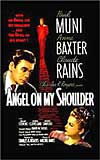 director John Cromwell's melodramatic tear-jerker fantasy, The Enchanted Cottage (1944) with magical spirituality in a story
about two lonely and misfit souls; a disfigured and embittered war veteran
named Oliver (Robert Young) and a homely and shy spinster named Laura (Dorothy
McGuire) who retreat to a secluded, seaside cottage to hide from the cruel
world, and there find restorative love, beauty, and youth director John Cromwell's melodramatic tear-jerker fantasy, The Enchanted Cottage (1944) with magical spirituality in a story
about two lonely and misfit souls; a disfigured and embittered war veteran
named Oliver (Robert Young) and a homely and shy spinster named Laura (Dorothy
McGuire) who retreat to a secluded, seaside cottage to hide from the cruel
world, and there find restorative love, beauty, and youth- Angel On My Shoulder (1946) the amusing fantasy
of a murdered gangster (Paul Muni) who makes a deal with the devil (Claude
Rains), is sent back to Earth, and takes possession of the body of a lenient
judge, in order to send more souls to Hades; remade in 1980
- director William Dieterle's hauntingly romantic fantasy Portrait of Jennie (1948), about a struggling, penniless artist (Joseph
Cotten) inspired by and in love with the vision of a strangely beautiful,
elfin girl (Jennifer Jones), suspected of being a spirit
Recent
Ghostly-Supernatural Tales:
Other notable, low-budget supernatural/horror films in the
late 1950s through the 1970s included:
- Bell, Book, and Candle (1958), a romantic fantasy
adapted from the Broadway stage comedy of the same name, with pre-Vertigo James Stewart (as a stodgy book publisher) and Kim Novak as his bewitching
Greenwich Village neighbor
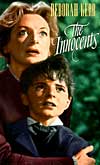 William Castle's ghost-infested B-movie House
on Haunted Hill (1959), starring Vincent Price as a wealthy and eccentric man who
offers $10,000 to his wife and others to survive one entire night in a ghostly
manse; with decapitated heads, vats of lye, crashing chandeliers; inspired
the parody Saturday the 14th (1981), and was remade in
1999 William Castle's ghost-infested B-movie House
on Haunted Hill (1959), starring Vincent Price as a wealthy and eccentric man who
offers $10,000 to his wife and others to survive one entire night in a ghostly
manse; with decapitated heads, vats of lye, crashing chandeliers; inspired
the parody Saturday the 14th (1981), and was remade in
1999- 13
Ghosts (1960), another haunted house thriller from William Castle, memorable
for its "Illusion-O" process (viewers were given the option of
using ghost-viewing glasses)
- director Jack Clayton's effective and definitive The
Innocents (1961), the British adaptation of Henry James' The
Turn of the Screw, with a repressed minister's daughter (Deborah Kerr)
hired as governess to a family with two orphaned children in a country estate,
who soon experiences spectral figures
- the spooky, cult zombie classic Carnival of Souls (1962),
about a dazed but unscathed woman (Candace Hilligoss) who survives a car
accident, but has visions of a ghoulish man and a 'carnival' of dead people
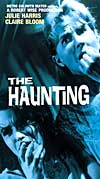 Robert Wise's suspenseful, subtle haunted house film The
Haunting (1963), based on Shirley Jackson's classic ghost story about
a group of folks brought together, by a parapsychologist and two mediums,
to spend a night in a spooky haunted Hill House - a family estate in New
England Robert Wise's suspenseful, subtle haunted house film The
Haunting (1963), based on Shirley Jackson's classic ghost story about
a group of folks brought together, by a parapsychologist and two mediums,
to spend a night in a spooky haunted Hill House - a family estate in New
England- The
Legend of Hell House (1973), a tale of the occult involving four researchers
(scientists and mediums) who spend one week in a newly-acquired house known
to be inhabited by malignant spirits; from scriptwriter Richard Matheson's
own novel Hell House
- John Carpenter's The Fog (1980) told about an evil
fog that envelopes a sleepy coastal town, shrouding the area's vengeful,
undead pirates; it was remade by director Rupert Wainwright (and Carpenter
as co-producer) as the PG-13 rated The Fog (2006) in a similar story
about inhabitants of a small California coastal town being terrorized by
an evil fog that covered a group of vengeful zombiefied sailors, with Selma
Blair taking the original Adrienne Barbeau role
Ghost Stories also abounded during the 80s and after:
- Peter Medak's tense haunted house entry The Changeling
(1980), with George C. Scott as a mourning widower who moved
into a haunted Seattle historical mansion, which ultimately manifested
a murder committed many years earlier in its attic
- Stanley Kubrick's stylish and overlong The
Shining (1980), a loose adaptation of Stephen King's novel, with
Jack Nicholson as an ex-alcoholic, failed writer who becomes the caretaker
of a huge, wintry Colorado resort and turns psychotic toward his family
as he resorts to the same behavior as the former caretaker who axe-murdered
his family in the past
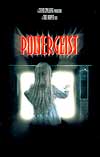 John
Irvin's Ghost Story (1981), based on the best-selling novel by Peter
Straub; about four elderly men (Fred Astaire, John Houseman, Melvyn Douglas,
Douglas Fairbanks, Jr.) in the Chowder Society social club, who share a
haunting, past secret John
Irvin's Ghost Story (1981), based on the best-selling novel by Peter
Straub; about four elderly men (Fred Astaire, John Houseman, Melvyn Douglas,
Douglas Fairbanks, Jr.) in the Chowder Society social club, who share a
haunting, past secret- Tobe Hooper's and co-producer Steven Spielberg's Poltergeist
(1982), about the Freeling suburban family who unknowingly lived
atop a Indian burial site with menacing spirits; followed by two sequels
(Poltergeist 2: The Other (1986), and Poltergeist
3 (1988))
- the comedy hit Ghostbusters (1984) and its sequel Ghostbusters II (1989)
- The Witches of Eastwick (1987), an anarchic, supernatural
comedy-horror film with supernatural elements, starring Jack Nicholson as
a womanizing, leering, and hedonistic devil, accompanied by three sultry
witches (Cher, Susan Sarandon, and Michelle Pfeiffer) in the New England
town of Eastwick
- The Lady in White (1988), a modern-day ghost story
set in a small town, about a young boy (Lukas Haas) haunted by the ghost
of a little girl
- Jerry Zucker's popular, romantic ghost story Ghost
(1990), about a brutally murdered, ghostly stock investment consultant
(Patrick Swayze), his endangered lover (Demi Moore), and a fake psychic
medium (Whoopi Goldberg in an Oscar-winning performance) who discovers she
has real psychic powers
 Hocus
Pocus (1993), with Bette Midler, Kathy Najimy, and Sarah Jessica Parker
as three resurrected witches from Colonial-days Salem brought back to life Hocus
Pocus (1993), with Bette Midler, Kathy Najimy, and Sarah Jessica Parker
as three resurrected witches from Colonial-days Salem brought back to life - the animated and live-action Casper (1995)
- The Craft (1996), starring a teenaged foursome (Robin
Tunney, Neve Campbell, Rachel True, and Fairuza Balk) of schoolgirls at
St. Benedict's Academy, who turn to witchcraft for revenge
- New Zealander director Peter Jackson's American film debut, The Frighteners (1996), a comedy-horror about a con man (Michael
J. Fox) in cahoots with a group of ghosts
- director Griffin Dunne's Practical Magic (1998) based on Alice Hoffman's novel, a drama-comedy about a family of spell-casting
witches (Nicole Kidman and Sandra Bullock as sisters), and two delightfully
magical aunts (Dianne Wiest and Stockard Channing)
- Jan de Bont's haunted house film The Haunting (1999) based on Shirley Jackson's novel The Haunting Of Hill House (also
used for Robert Wise's The Haunting (1963))
- M. Night Shyamalan's intriguing The Sixth Sense (1999),
with Haley Joel Osment as a young boy who can communicate with ghosts ("I
see dead people"), and Bruce Willis as his child psychiatrist
- Tim Burton's gothic ghost story Sleepy Hollow (1999) based upon Washington Irving's tale of Ichabod Crane and the Headless Horseman
- director Robert Zemeckis' slick and suspenseful thrill-fest What Lies Beneath (2000), with Harrison Ford and Michelle Pfieffer
as a seemingly happily-married couple; with ghost-possession, a menacing
bathtub, and a twisting plot
- The Others (2001), director Alejandro Amenabar's first American film, a creepy and classic ghost story with Nicole
Kidman as an overprotective mother with two children in a musty and darkened
mansion
- Gore Verbinski's The Ring (2002) - a remake of Hideo
Nakata's Japanese film Ringu (1998) - with a plot that recalled both Poltergeist (1982) and Videodrome (1982) in which television served as a medium for an evil force
- Steve Beck's Ghost Ship (2002) and David Twohy's
horror-war film Below (2002), released about the same time, were
both supernatural ghost tales set on sunken ships
- M. Night Shyamalan's 19th century suspense tale, The
Village (2004), about a village in rural Pennsylvania next to woods
where mythical creatures reside
|
